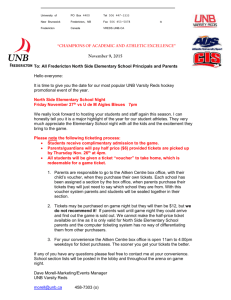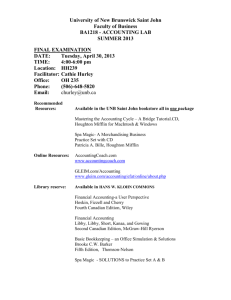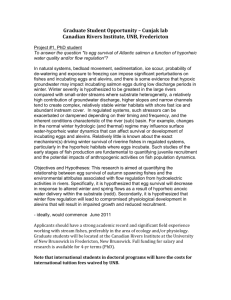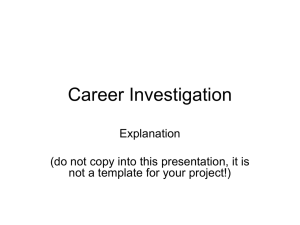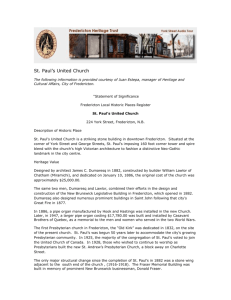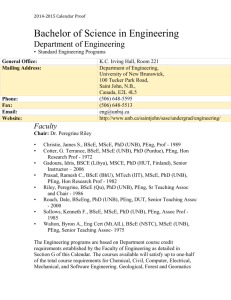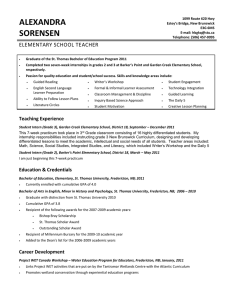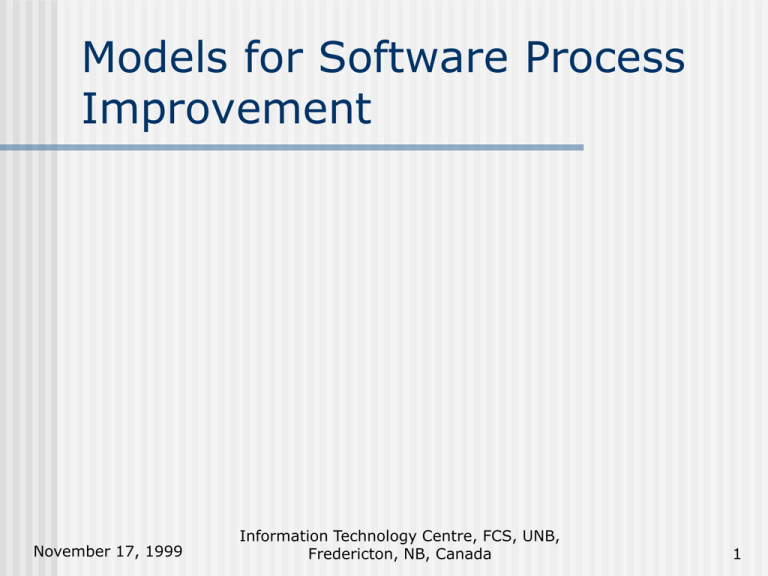
Models for Software Process
Improvement
November 17, 1999
Information Technology Centre, FCS, UNB,
Fredericton, NB, Canada
1
Software Process - Overview
Objectives for Process Improvement
History of Process Models
Models (CMM, ISO, IEEE)
Best Practices
“Good-enough” Software
November 17, 1999
Information Technology Centre, FCS, UNB,
Fredericton, NB, Canada
2
Software Process: Objectives
schedule (delivery date)
functionality
quality
(features)
(defects)
November 17, 1999
Information Technology Centre, FCS, UNB,
Fredericton, NB, Canada
3
Software Process: History
1980s DoD Std 2167, AQAP 13 (NATO),
industry standards (nuclear)
1983 IEEE 730 (software quality
assurance plans)
1987 ISO 9000
1988 TickIT (ISO 9001)
1990 ISO 9000-3 (guideline for software)
1991 Capability Maturity Model (CMM)
1992 SPICE (ISO 15540)
November 17, 1999
Information Technology Centre, FCS, UNB,
Fredericton, NB, Canada
4
Software Process: History
State-of-the-art software practices in 1984,
for large software systems [Jones, 1995]:
• More than half were late in excess of 12 months
• Average cost was more than twice the initial
budget
• Cancellation rate exceeded 15%
• Quality and reliability was poor, for both small
and large projects
• Software personnel were increasing by more than
10% per year
• Software was the largest known business
expense that could not be managed
November 17, 1999
Information Technology Centre, FCS, UNB,
Fredericton, NB, Canada
5
Software Process: Productivity
• U.S. Software Development – Productivity Trends
[Yourdon]
November 17, 1999
Information Technology Centre, FCS, UNB,
Fredericton, NB, Canada
6
Software Process: Productivity
• Range of Productivity at Enterprise Level [Yourdon]
November 17, 1999
Information Technology Centre, FCS, UNB,
Fredericton, NB, Canada
7
Software Process: Quality
• U.S. Software Development – Quality Trends [Yourdon]
November 17, 1999
Information Technology Centre, FCS, UNB,
Fredericton, NB, Canada
8
Software Process: Quality
• Range of Quality at Enterprise Level [Yourdon]
November 17, 1999
Information Technology Centre, FCS, UNB,
Fredericton, NB, Canada
9
Software Process: Models
CMM
U.S. DoD
ISO
Industry,
professional
(c) 1998 Software Productivity Consortium MFP, Inc. All rights reserved.
Refer: http://www.software.org/quagmire/
November 17, 1999
Information Technology Centre, FCS, UNB,
Fredericton, NB, Canada
10
Software Process: CMM
Developed by Software Engineering
Institute (SEI), Carnegie Mellon
Funded by U.S. DoD, concerned with late
and cancelled contracts (A12, $58 billion)
For large projects, contractors must be
assessed at Level 3 or DoD equivalent
(October 1999)
Capability Maturity Model for Software
(SW-CMM) v1.1, February 1993.
November 17, 1999
Information Technology Centre, FCS, UNB,
Fredericton, NB, Canada
11
Software Process: CMM
•Maturity level
(historical,
continuous
improvement)
•Key process
•Key practice
(infrastructure,
activities)
November 17, 1999
Information Technology Centre, FCS, UNB,
Fredericton, NB, Canada
12
Software Process: CMM
1.
2.
3.
4.
5.
Initial. The software process is characterized as ad hoc, and occasionally
even chaotic. Few processes are defined, and success depends on
individual effort and heroics.
Repeatable. Basic project management processes are established to track
cost, schedule, and functionality. The necessary process discipline is in
place to repeat earlier successes on projects with similar applications.
Defined. The software process for both management and engineering
activities is documented, standardized, and integrated into a standard
software process for the organization. All projects use an approved, tailored
version of the organization's standard software process for developing and
maintaining software.
Managed. Detailed measures of the software process and product quality
are collected. Both the software process and products are quantitatively
understood and controlled.
Optimizing. Continuous process improvement is enabled by quantitative
feedback from the process and from piloting innovative ideas and
technologies.
November 17, 1999
Information Technology Centre, FCS, UNB,
Fredericton, NB, Canada
13
Software Process: CMM
• Processes are
managed, controlled
November 17, 1999
Information Technology Centre, FCS, UNB,
Fredericton, NB, Canada
14
Defects
Software Process: CMM
0
quality := 0 defects
1
November 17, 1999
2
3
4
Process
Information Technology Centre, FCS, UNB,
Fredericton, NB, Canada
15
Software Process: CMM
0.5% [Jones, 1995]
1.5%
8.0%
15.0%
75.0%
November 17, 1999
Information Technology Centre, FCS, UNB,
Fredericton, NB, Canada
16
Software Process: PSP
Personal Software Process (PSP),
Watts Humphrey, SEI
Process model for individual
programmers or small companies
Detailed examples of key practices,
including software metrics
November 17, 1999
Information Technology Centre, FCS, UNB,
Fredericton, NB, Canada
17
Software Process: ISO
International Organization for
Standardization, 130 countries
Including Canada (SCC) and U.S
(ANSI)
ISO 9000 – guidelines and
standards for process control
Sector-independent (applies to any
product or service)
November 17, 1999
Information Technology Centre, FCS, UNB,
Fredericton, NB, Canada
18
Software Process: ISO
November 17, 1999
Information Technology Centre, FCS, UNB,
Fredericton, NB, Canada
19
Software Process: ISO
Three “models” of a quality management
system for a product or a service:
ISO 9001 (1994) – Model for quality
assurance in design/development, production,
installation, and servicing
ISO 9002 (1994) - Model for quality
assurance in production and installation
ISO 9003 (1994) - Model for quality
assurance in final inspection and test
November 17, 1999
Information Technology Centre, FCS, UNB,
Fredericton, NB, Canada
20
Software Process: ISO
ISO 9001 (Scope):
used where a supplier's capability to
design and supply conforming product
needs to be demonstrated.
aimed primarily at achieving customer
satisfaction by preventing nonconformity at all stages from design
through to servicing
November 17, 1999
Information Technology Centre, FCS, UNB,
Fredericton, NB, Canada
21
Software Process: ISO
quality := totality of characteristics of an entity (process,
product, organization) that bear on its ability to satisfy stated and
implied needs (ISO 8402)
November 17, 1999
Information Technology Centre, FCS, UNB,
Fredericton, NB, Canada
22
Software Process: ISO
Framework
Management responsibility
Quality system
Internal QS audits
Corrective action
Life-cycle
Contract review
Requirements specification
Development planning
Quality planning
Design and implementation
Testing and validation
Acceptance
Delivery and installation
Maintenance
Support
Configuration management
Document control
Quality records
Measurement
Rules, practices and conventions
Tools and techniques
Purchasing
Included software product
Training
minimum best practices
November 17, 1999
Information Technology Centre, FCS, UNB,
Fredericton, NB, Canada
23
Software Process: TickIT
Registration scheme for software in
Britain and Sweden
Certificates are issued against ISO
9001
Assessors and auditors are software
professionals
November 17, 1999
Information Technology Centre, FCS, UNB,
Fredericton, NB, Canada
24
Software Process: SPICE
Software Process Improvement and
Capability dEtermination (ISO
15540)
ISO standard will “harmonize” ISO
and CMM
November 17, 1999
Information Technology Centre, FCS, UNB,
Fredericton, NB, Canada
25
Software Process: SPICE
•5 process
categories
•40 processes/subprocesses
[Duncan, 1998]
November 17, 1999
Information Technology Centre, FCS, UNB,
Fredericton, NB, Canada
26
Software Process: SPICE
•For a given process to
achieve a Level, all
lower level attributes
must be Fully met and
all attributes at the
target level must be
Fully or Largely met
[Duncan, 1998]
November 17, 1999
Information Technology Centre, FCS, UNB,
Fredericton, NB, Canada
27
Software Process: IEEE
How to implement a life-cycle model?
730 Software Quality Assurance Plans
828 Software Configuration Management
Plans
829 Software Test Documentation
830 Software Requirements Specifications
1008 Software Unit Testing
1016 Software Design Descriptions
November 17, 1999
Information Technology Centre, FCS, UNB,
Fredericton, NB, Canada
28
Software Process:Best
Practices
Best Practices project, DoD, 1994
Focus on practices instead of
complex regulations
Encourage flexibility within disparate
environments
Identified 170 best practices
URL: http://spmn.com/ (Software
Program Managers Network )
November 17, 1999
Information Technology Centre, FCS, UNB,
Fredericton, NB, Canada
29
Software Process: Best
Practices
Formal risk management
Agreement on interfaces (user manual as specification)
Formal inspections
Metric-based scheduling and management
Binary quality gates at the inch-pebble level
Program-wide visibility of progress vs. plan
Defect tracking against quality targets
Configuration management
People-aware management accountability (qualified
staff, high morale, low turnover)
November 17, 1999
Information Technology Centre, FCS, UNB,
Fredericton, NB, Canada
30
Software Process: Goodenough Software
schedule (delivery date)
functionality
quality
(features)
(defects)
November 17, 1999
Information Technology Centre, FCS, UNB,
Fredericton, NB, Canada
31
Software Process: Goodenough Software
Target is “feature-richness”
Customer (marketing) decides the
balance between schedule, functionality,
quality
Processes are dynamic, evolutionary
Depends on best practices, e.g., user
manual, peer reviews, daily build
Depends on guerilla programmers
November 17, 1999
Information Technology Centre, FCS, UNB,
Fredericton, NB, Canada
32
Software Process: Conclusion
no best model, none is complete
people are key (managers, quality
managers, developers)
bottom-up vs top-down (cost,
infrastructure)
reasons:
business requirement (certification)
productivity (better, cheaper, faster)
November 17, 1999
Information Technology Centre, FCS, UNB,
Fredericton, NB, Canada
33
Software Process: References
• http://www.sei.cmu.edu/ (Software Engineering Institute)
• http://www.iso.ch/ (International Organization for Standardization (ISO))
• http://www.sqi.gu.edu.au/spice/ (SPICE, Software Quality Institure)
• http://www.tickit.org/index.htm (TickIT, British Standards Institute)
• http://www.scc.ca/iso9000/index.html (Standards Council of Canada, ISO)
• http://strategis.ic.gc.ca/ (ISO 9001 Registration for Small and MediumSized Software Enterprises, Industry Canada)
•http://www.computer.org/standards/ (IEEE Computer Society,)
•http://www.ieee.org/index.html (IEEE Home)
November 17, 1999
Information Technology Centre, FCS, UNB,
Fredericton, NB, Canada
34
Software Process: References
• http://www.nbita.org/spin/index.html (NBITA)
• http://www.spc.ca/ (Software Productivity Center Inc)
• http://www.software.org/ (Software Productivity Consortium)
• http://www.rspa.com/spi/ (Software Engineering: A Practitioner's
Approach, R.S. Pressman & Associates, Inc)
• http://www.spr.com/index.htm (Software Productivity Research, Capers
Jones)
• Jones, Capers. “Gaps in SEI Programs”, Software Development, March
1995
• http://catless.ncl.ac.uk/Risks (The Risks Digest, P.G. Neumann)
• http://stsc.hill.af.mil/doc/resources.asp (MIL-STD-498 documents)
• Duncan, S.P., “Standards & Models”, HTML document,
http://www.mindspring.com/~softqual/stdsmods.html, 1998
November 17, 1999
Information Technology Centre, FCS, UNB,
Fredericton, NB, Canada
35

